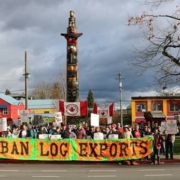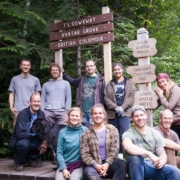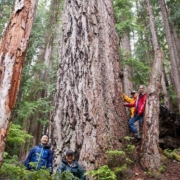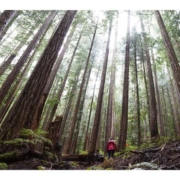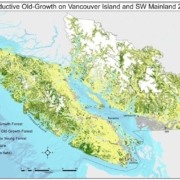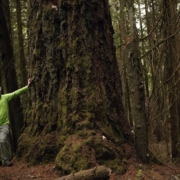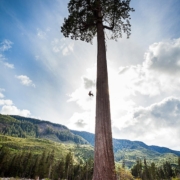Here’s a very insightful article about the shift underway in the economy and attitudes among the business community and in rural communities (spearheaded by the efforts of the Port Renfrew Chamber of Commerce and the Ancient Forest Alliance, with a growing chorus of voices gathering steam, including the BC Chamber of Commerce and the AVICC) towards favouring increased protection of old-growth forests – in part to support a more sustainable economy! This is worth sharing!
Again take note that the BC government and logging industry’s stats on how much old-growth remains and is protected are deliberately misleading by including stunted non-commercial bogs and subalpine stands on steep rocky mountainsides with the productive stands with big trees targeted by the logging industry, and by combining the northern rainforest (the Great Bear Rainforest) where huge progress in protection levels has occurred as a result of environmental boycotts of logging companies (followed by 15 years of negotiations) along with the southern rainforest (Vancouver Island and the southwest mainland) where protection levels are very minor, old-growth forests have been much more heavily logged, and the forests are different (ie. different biodiversity, ecosystems, and generally much larger, grander ancient trees), ie. the northern and southern coasts are two very different regions and should not be confused and mixed together, unless your goal is to mislead people…
*********
It stands at a little more than 70 metres high, 14 metres taller than the Leaning Tower of Pisa.
Experts believe it may have been around even longer than the world-famous Italian landmark, which began to take shape nearly 850 years ago.
Big Lonely Doug looms over a clearcut hillside in the Gordon River Valley, surrounded by stumps and scrub brush, maybe 15 kilometres northwest of Port Renfrew.
The second-biggest tree in Canada, this massive Douglas fir is, for some, a a stark reminder of the glory days of Vancouver Island logging, when massive old-growth timber fed myriad sawmills, sparking a booming industry that made towns like Port Alberni and Lake Cowichan rich.
But in the wake of a media blitz in 2014, Doug has found itself with something else in common with the Leaning Tower: it has become a destination.
And with that, it has also become a symbol of a dramatic shift in Island thinking.
Citing the power of old growth trees as a tourism resource, Vancouver Island communities voted in April to seek a total ban on old growth harvesting on the Island’s Crown land.
And they received support this week from a surprising source: the B.C. Chamber of Commerce, which voted to support the same principle across the province in instances where old growth trees “have or can likely have a greater net economic value for communities if they are left standing.”
The Renfrew Tall Trees Experience
Dan Hager runs a Port Renfrew cottage rental business called Handsome Dan’s Accommodations. He is the president of the community’s chamber of commerce and the one who successfully pitched the old growth resolution to the B.C. chamber.
While he lauds old growth for its environmental benefits, he said the main motivations for the chamber motion were dollars and sense.
“It just boils down to basic math. This is not a comment about logging. It’s about economics and marketing,” he said. “Port Renfrew now has a product people can’t get anywhere else.”
In 2012 the Victoria-based environmental watchdog group the Ancient Forest Alliance successfully lobbied to protect an extraordinary grouping of trees near Port Renfrew it dubbed Avatar Grove.
In the months that followed, increasing numbers of visitors began to pour into the community. Hager said the community didn’t do any scientific studies as to why, but conversations and guestbook entries made it obvious: prompted by media reports, they were there to see the majestic trees.
He told the B.C. chamber that since that summer, accommodation providers in Port Renfrew have reported demand for accommodations has increased 75% to 100% annually. And he said the visitor streams continue outside the summer fishing season — typically the only time visitors had previously been coming.
Entirely by accident, the environmental movement had given the 300-resident town an unexpected economic boom.
“Thanks to the trees, Port Renfrew is no longer a one-industry tourism town and has been able to successfully brand itself the Tall Tree Capital of Canada,” he said. “They created Avatar and we benefitted from it.”
Hager said he no trouble convincing the business community this is an opportunity other B.C. regions can and should be taking advantage of. He relayed his message through the following example.
“In 2012 a kayaking company in Discovery Islands did an illuminating economic analysis. It calculated the economic value of 60 hectares of timber scheduled to be logged above and around the kayaking base camp across from the world-famous Robson Bight.
“It was determined that the value of the 60 hectares of timber was worth about $3.6 million. Since the regeneration cycle meant the area could be cut only once every 60 years, the yearly economic value of the timber was $60,000.
“The economic value to the kayaking company, however, was $416,000 per year, or $24.96 million for the same 60-year period. In stark contrast to the approximately 300 person-days employment from logging the 60 hectares just once, the kayaking company provided 20,160 person-days of employment during the 60-year cycle.
“And this simple economic analysis didn’t include the employment and earnings for the 40 other ecotourism businesses using the same area.”
He said it is the government’s role to do what’s best for communities and increasingly that means letting trees stand.
“In Port Renfrew there are maybe a a half-dozen people that gain their living from forestry. A lot more than that get it from tourism.”
Concerned Industry Warns Of Crisis
Hager wants to make it clear: the B.C. chamber did not endorse an old-growth logging ban, what it endorsed was protection for those old growth stands that generate more economic benefits for communities if they are left standing.
But the Association of Vancouver Island and Coastal Communities went a step beyond that in April when members voted to ask the provincial government to amend the Vancouver Island Land Use Plan to protect all of Vancouver Island’s remaining old growth forest on provincial Crown land.
According to David Elstone, executive director of Truck Loggers Association, a ban on old growth logging would devastate the industry.
Elstone was caught off guard by both motions and unclear why there has been a shift in thinking from organizations that have traditionally been in the industry’s corner.
“In general, I am concerned about the tone and the concept. Don’t know if all the facts are being drawn forward,” Elstone said. “I don’t want to fall back on being alarmist, but if you suddenly turn that off there doesn’t take much imagination to see the impact.”
Rick Jeffery, president and CEO of Coast Forest Products Association, agreed and was concerned both the AVICC and the B.C. chamber may have made decisions in absence of all the facts.
“I have no idea on what basis they are making these claims. I just don’t,” he said. “I was surprised they didn’t ask us.
“Our take-home message is that we have to sit down and talk. We will bring facts and figures.”
One message Jeffery wants to get across is that forestry and conservation already co-exist in local forests. Another is that 55 per cent of the old growth on the B.C. coast is already protected, something he says will increase over time due to conservation practices in the unprotected areas.
“Old growth is going to be here forever,” he said. “People don’t understand that.”
Elstone said 45 per cent of the coastal harvest comes from old growth trees. Forestry accounts for 38,000 direct jobs on the Island and the neighbouring coast, and 61,000 across the province.
Would a ban old growth harvesting mean a loss of 45% of the jobs?
“You’d probably lose a lot more than that,” he said.
Jeffery said certain mills are only set up to process old growth and the industry as a whole depends on economies of scale it would not be able to sustain, leading clients to look elsewhere.
“You would have an average allowable cut drop,” he said. “It would put a lot of mills out of business and put pulp mills in jeopardy.”
According to Elstone, the word “crisis” would not be an overstatement.
“It’s a vital part of our history and always will be an integral part of the success of our communities,” he said. “There are still a hell of a lot of communities that rely on forestry. We need to protect our working forests or else there will be significant impact.”
To help determine the degree of that impact, Black Press contacted Susan Mowbray, senior economist with MNP and author 2015’s State of the Island Economic Report.
Her answer is that it is impossible to tell when the economic benefits of an old growth logging halt would exceed those of continued harvesting without further study. One can’t simply subtract the loss of those logs without considering the spin-off effects.
“If, all of sudden, you can’t harvest the old growth (in a certain location), it may not make sense to harvest the low value timber there either,” she said.
She added the lack of consideration of such variables makes her very skeptical that the Discovery Islands kayaking case presented by Hager to the BC chamber painted a realistic picture. For example, every forestry job creates 1.5 other jobs. Tourism jobs don’t have the same impact.
“There are some jobs that get substituted. The difference is forestry jobs are higher-paying,” Mowbray said. “There needs to be a better understanding of what it means. In some communities forestry is all there is.
“More analysis has to be done before I can unequivocally say.”
A shifting community mindset?
A possible test case for such an analysis could be Tofino, the poster child for replacing a resource-based economy with eco-tourism. Mowbray said she has yet to crunch those numbers.
Anecdotally, Tofino Mayor Josie Osborne said embracing and protecting the rainforest certainly seems to working there.
A lifelong Island resident, she agreed the mindset of Island residents has definitely been shifting.
“Yes, I really think it is. Global tourism is on the rise, the role of primary resource extraction has changed.”
While councillors from communities like Port Hardy and Port Alberni spoke out against the AVICC motion — presented by Metchosin — as being too broad, or too damaging to the north Island, she said a majority embraced it as necessary in shaping the direction of the Island’s future.
“I think that 10 or 15 years ago it would have been more contentious,” she said. “When things become rare, we value them more. Frankly it’s something I’ve come to expect from Vancouver Island. There has been much more thinking like an Island, realizing that we are all in this together.”
Port Hardy councillor Fred Robertson believes part of that should also be a recognition that well-managed forests are crucial to a healthy north Island. While he respects the opinions expressed by his neighbours further south, he thinks they have to consider that old growth logging may still have a net benefit in some parts of the Island.
“In my mind it doesn’t have to be an either-or,” he said. “It’s important to understand all perspectives. There is an economic and social impact in communities like ours.”
”You can have working forests and still attract people to a pretty spectacular part of the world.”
Elstone said that as the industry has shrunk residents of some communities may have lost their perspective on its overall importance.
“There has probably been a migration from urban centres into our smaller communities,” he said.
James Byrne, regional managing partner with MNP and another lifelong Island resident, said some may have lost sight of how valuable logging is in communities like Campbell River, Port Hardy and Woss and how the harvest feeds businesses further south.
“Don’t estimate the importance of old growth. Logging is not what it used to be, but it still has a significant impact up and down the Island,” he said.
Sierra Club campaigner Jens Wieting doesn’t dispute that, only its relative significance.
“Logging no longer has the same economic importance,” he said. “We have two trends: there are fewer benefits from logging and increasing benefits of keeping trees standing.”
Wieting echoed Osborne in saying old growth preservation has worth beyond the economy: water conservation, clean air and the spiritual satisfaction of preserving an ecology found nowhere else in the world are values more Vancouver Islanders have embraced.
He said despite the fact 15 per cent of the Island’s forests are protected, only three per cent of its biggest, most iconic trees are safe from harvesting.
“People are still looking for places where they can find intact nature,” he said. “When are we going to make the transition? The time to make the shift on Vancouver Island is overdue.”
Wieting was instrumental in the push that led to protection of 85 per cent of the Great Bear Rainforest. The preservation of Vancouver Island’s remaining old growth forests is the environmental movement’s next big target.
Getting a majority of Island communities, as well as the provincial business community on side is a big step.
“This is indeed huge. It is a reflection of the shifting landscape,” he said. “I feel very privileged to live in this part of the world. It is really something you can’t find anymore anywhere.”
[Original BC Local News article no longer available]

